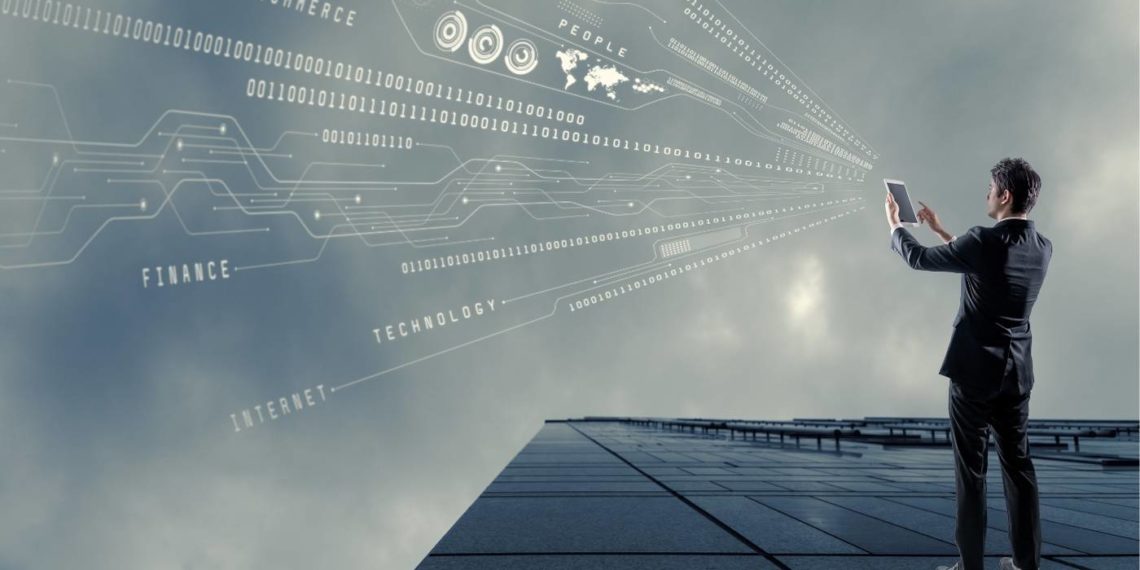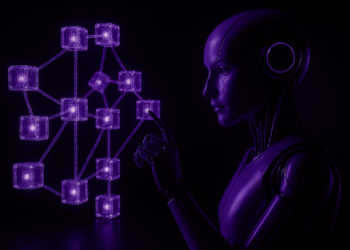It can be said that crises are excellent levers of acceleration. However, this is not the impression that might immediately emerge from our experience of the various lockdowns. Rather, the health crisis has brought our lives and our businesses to a halt, or even completely to a standstill.
But, if there is one area where everything does seem to have accelerated in recent months, it is that of the digital transformation of our societies in general, and of companies in particular. Thus, according to the Growth & Digital Barometer published in 2019 by Ipsos, 70% of businesses saw digital as an opportunity at that point. On the other hand, less than one in two was piloting a truly committed strategy in the direction of digital transformation.
The came the game-changer: COVID-19. ‘Companies,’ confirms Vincent Bouillon, CEO of WeDigitalGarden, ‘had no other choice but to initiate their transition at a pace’. The crisis, adds Éric Ducasse, director of the Wemanity transformation service, represented ‘the opportunity for organisations to review their practices, find new solutions and gain almost 7 years in the digitalisation process.’ But do your teams know exactly what digital transformation entails?
1. Do you speak digital?
Not sure. In their defence, it must be acknowledged that the multitude of expressions on the web does not make it easy to define the phenomenon. What, in fact, is the difference between ‘IT transformation’ and ‘digital transformation’? What is the difference between ‘digitalisation’ and ‘digitisation’? Even for our experts, these distinctions can be hard to tease out! ‘It’s more of an academic argument really,’ explains Vincent, ‘because if there is any difference, it is semantic’. There is still some confusion between the differences and overlaps between the IT transformation and the digital transformation. Some might use them interchangeably, but they are not quite the same.
Definition: ‘IT transformation’ refers to the technological dimension; with ‘digital transformation’, we are moving to the user side.
The purists? Above all, they will remind you that ‘originally, computing is base on numbers’, that it is by definition opposed to ‘analogue’ by presenting information in the form of 0 and 1. By extension, the ‘IT transformation’ would then refer to everything related to technologies. It would relate, in concrete terms, to the establishment of new networks, the deployment of the Internet of Things or the management of cloud-type data storage.
With ‘digital’, we would go over to the users, their experience of digital technology, what they do with their fingers, their ‘digits’, to echo the etymology. Basic values versus use values is the key to understanding. But if things are not so easy to disentangle, it’s because IT transformation encompasses digital transformation.
2. A digital transformation in three dimensions
The 3 axes of digital transformation: customer relations, new services and processes
For companies, it revolves, according to Vincent, around three main axes:
- The first concerns customer relations, how to communicate with them by sending them emails or notifications, as well as the whole CRM dimension well known to marketing departments.
- The second concerns the creation, and therefore the use, of new services which are all business opportunities grafted around traditional businesses. This is the case, for example, with the drive.
- Finally, the third axis is built around the process of empowerment or improvement, the implementation of which is increasing every day and in all sectors to gain in efficiency and productivity.’
Digital transformation is therefore not new, as evidenced by changes relating to customer relations, CRM or processes. On the other hand, one more recent dimension is the one linked to the emergence of new services. And it goes hand in hand with a sort of contraction of the world. ‘From now on, just through its presence on the web,’ explains Éric, ‘a neighbourhood SME can reach any customer anywhere in the world. This induces a change in the concept of competition’.
With today’s technologies, nothing prevents new entrants from stepping on the toes of the behemoths in their sector. How? ‘With more disruptive products and greater agility’. But, observes our expert, ‘we are also witnessing a change in consumption patterns’. One click is enough to ‘switch from one product to another, from one service to another’.
Digitalisation: maximum impact factor
Because, yes, digitalisation does not stop at the doors of the company. Its impacts on our daily lives rack up by the dozen! From our ways of consuming to our social interactions, from our romantic dates to our ways of working: digital has changed everything. ‘The digital revolution is creating an anthropological revolution and, in return, human society is evolving. This therefore generates, hand-in-hand with digital, new uses, new behaviours, new products’… which are products in name only! Who would have thought, in fact, that one day a giant in the hotel industry would not have an establishment of its own?! Yet this is the case with Airbnb. ‘Nothing manufactured comes from Airbnb, any more than from Uber which does not own any cars’. No product on the shelves and Vincent finds this ‘fascinating!’
The observation: ‘The digital revolution is creating an anthropological revolution which in turn is generating new uses, new behaviours, and new products.’
Equally fascinating: getting lost in the meanders of the ever-larger catalogues of VOD platforms. With digital technology, it has become easier to have fun or learn more about yourself. Bureaucratic red tape is gone too! Administration is also getting into the digital age and Big Data. Technology is therefore not content to simply ‘push us to hyperconsumption. It is also decongesting public services!’
But, in many countries, the use of digital is not without risk. Data tracing, digital identity theft, online commercial fraud, security breach, breach of network privacy, and more. Our whole life is now in the cloud. The Internet is now even raising issues of sovereignty.
One example among many? The problematic tax optimisation of GAFAM, the net giants unhindered by any geographical border. To regain control, many states are starting to legislate. ‘They are certainly right,’ notes Eric, ‘because things change as soon as political power takes hold of them’. But, regrets Vincent, ‘on environmental or societal issues, we are still at the stage of compensation policies’. And these regulatory manoeuvres take time. However, digital technologies have sounded the death knell for our patience!
3. Digital transformation: between acceleration and resistance
‘Ubiquity and speed are, in fact, the key words of digital transformation’. The proof? Our irritation in the waiting room of virtual meetings or when faced with opening web pages that are too slow… This phenomenon of acceleration, a contradictory aspect, is experienced daily by companies. They must constantly transform themselves or risk competition or death. ‘Our role therefore consists in helping our customers to go faster, to equip them with the best tools, to direct them in the right direction so that they offer the right service and aren’t disrupted’.
The key words of digital transformation: Ubiquity and speed
And large groups are no exception. As a result, they are increasing their communication and marketing campaigns to invite Generation Z to join their ranks. ‘They are becoming more and more imaginative in offering incubator or funding programmes for start-ups.’ The problem? These types of businesses are not necessarily compatible. ‘Their collaboration can therefore quickly turn into a clash of cultures and,’ ultimately, ‘failure’. Vincent and Éric’s teams then intervene ‘to reflect with clients on the best way to integrate a start-up spirit into their organisation’.
Another source of resistance? Management. When it comes to transformation, expectations are rarely naturally aligned. But this is not inevitable! ‘Top management must make it possible to provide the minimum framework. ‘However, very often,’ Eric believes, ‘this framework is poorly set’. What is worse, operational teams are not told why a transformation is being launched. On the other hand, they’re simply told how to implement it!
The observation of our experts is clear: ‘This doesn’t work either. It is preferable to allow employees to express themselves, to use new digital tools, to take control of working methods’. In short, the challenge is to ‘support the different layers to be managed differently, to de-silo organisations to improve the customer experience as well as that of employees’.
4. Humans before digitalisation
Digital-driven models are, in fact, more decentralised. ‘The company’, hopes Vincent, ‘will be inspired by it to have more confidence in its employees, to give them more autonomy’. A desire for independence rekindled by the health crisis. The widespread use of remote work has perfectly demonstrated that decentralisation does not necessarily mean loss of control. It simply involves working differently, sometimes from anywhere in the world and often collaboratively thanks to technology.
It’s your turn!: ‘The difficulty is not the technology. It is all about the human’.
This movement of decentralisation makes the place of the company all the more salient. From now on, we are waiting for it to play its part, in concert with the state and civil society. The goal? To fully confront the challenges raised by digital technology. ‘From CSR to data management, the company definitely has a role to play’. And there is no question of just running it for a marketing stunt. It would do them no service. Eric remarks that ‘wondering how to make your service greener is no longer enough.’ Companies must rethink their services to ensure that the green is fully part of them’.
Some start-ups have understood this perfectly. But, reassures Vincent, ‘there is still room for the creation of new missions, new projects, new practices’. Moreover, VSEs/SMEs may have more to gain from it since ‘changing the way they operate is much less complicated than in a large group’.
Their organisation on a ‘human scale’ also makes them better able to place people at the heart of their digital transition. Because, after all, digitalisation is first and foremost a human matter. For our experts, ‘it is moreover all about the human. The difficulty is not the technology’. Of course, to become the next unicorn, you have to have the right idea and, if possible, at the right time!
But how do you achieve this without convincing the world of the relevance of your services? How to go from 10 to 500 employees without hiring them? How to build your marketing strategy without taking into account the needs of its customers? How to sell your solutions online without taking care of the communication to your community?
‘We find people from one end of the chain to the other’. Without it, no progress. It is often the first brake in transformations. It is above all a place of contradiction, dissatisfied with his bullshit job one day, a customer of a meal delivery platform the next… ‘It’s all about the human’. So it’s up to him, yes, it’s up to all of us to decide what we do with the digital transformation .












